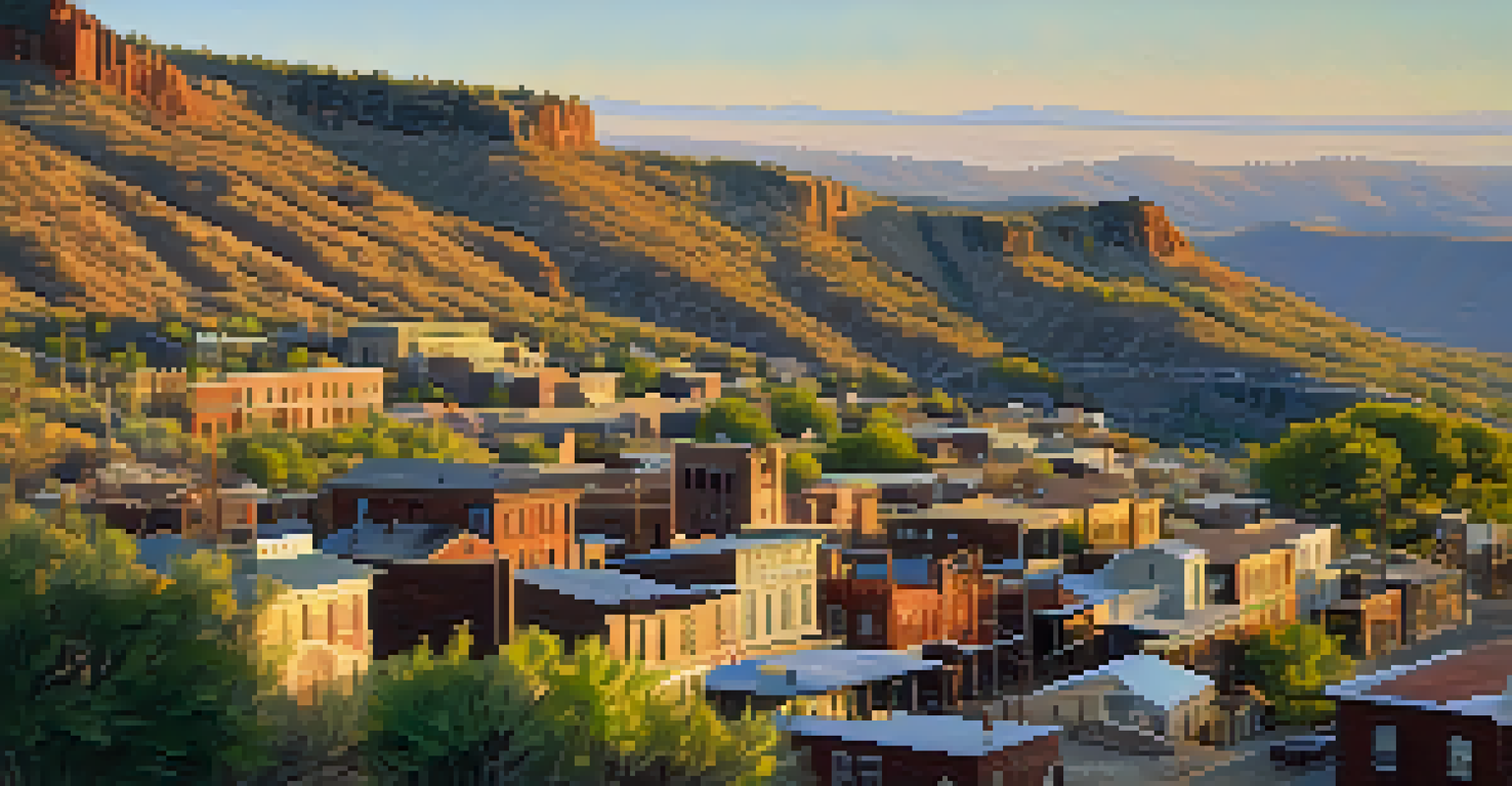Ghost Towns of Arizona: Echoes of the Mining Past

Introduction to Arizona's Ghost Towns and Mining Heritage
Arizona is a state rich in history, particularly when it comes to its mining past. Once bustling with activity, many towns have since become ghostly remnants, preserving stories of ambition and hardship. These towns serve as a portal to a bygone era, where the allure of gold and silver drew thousands into the wilderness.
The past is never dead. It's not even past.
As you drive through Arizona, you might stumble upon these abandoned settlements, each with its own unique tale. From the hopeful pioneers who sought fortune to the eventual decline as resources dwindled, these echoes of the past are fascinating. They remind us of the relentless pursuit of prosperity and the inevitable passage of time.
In this article, we will explore several of these ghost towns, uncovering their histories and the reasons behind their decline. By delving into their stories, we not only honor the past but also learn valuable lessons about resilience and change.
The Allure of Gold: The Rise of Mining Towns
The discovery of gold in the mid-1800s sparked a rush that transformed Arizona's landscape. Towns like Tombstone and Bisbee sprang up almost overnight, filled with hopeful miners seeking their fortunes. These towns became vibrant hubs of commerce, culture, and community, as people from all walks of life converged.

As the mining industry flourished, so did the infrastructure of these towns. Businesses, schools, and even theaters emerged, creating a bustling social scene. The promise of wealth and opportunity attracted more settlers, turning these once-empty patches of land into thriving communities.
Arizona's Mining Heritage
Arizona's ghost towns are remnants of a rich mining history that attracted thousands seeking fortune in gold and silver.
However, the allure of gold was often short-lived. Once the mines began to close or production diminished, many towns faced an exodus of residents, leading to their eventual decline. This pattern is a common theme in the history of Arizona's ghost towns, showcasing the fragility of success.
Tombstone: The Town Too Tough to Die
No discussion of Arizona's ghost towns would be complete without mentioning Tombstone, famously known as 'The Town Too Tough to Die.' Established in 1879, it became one of the most infamous mining towns, famed for its silver boom and legendary gunfights, including the iconic shootout at the O.K. Corral.
History is not a burden on the memory but an illumination of the soul.
Despite its decline after the silver market crashed, Tombstone has managed to retain much of its historical charm. Today, it stands as a living museum, attracting tourists eager to experience its Wild West atmosphere. Visitors can explore restored buildings, enjoy reenactments, and learn about its colorful history.
Tombstone's resilience is a testament to the spirit of its early settlers. While it may not be a bustling mining hub anymore, it remains a vibrant reminder of Arizona's rich heritage and the stories that echo through its streets.
Bisbee: A Bohemian Retreat Amidst Ruins
Nestled in the Mule Mountains, Bisbee offers a unique blend of history and artistry. Once one of the largest copper mining towns in Arizona, its vibrant past is reflected in its colorful architecture and eclectic community. After the mines closed, Bisbee transformed into a haven for artists and creatives, breathing new life into its deserted streets.
Today, visitors can wander through its hills, exploring art galleries, charming shops, and local eateries. The town's rich history is preserved in its architecture and museums, making it a fascinating destination for history buffs and art lovers alike. Bisbee's transformation showcases the adaptability of communities in the face of change.
Resilience of Ghost Towns
Many ghost towns, like Tombstone and Bisbee, showcase the adaptability of communities that transformed after mining declined.
The spirit of Bisbee lives on, proving that even ghost towns can find new purpose. Its story is a reminder that history is not merely about what was lost, but also about what can be created from the remnants of the past.
Jerome: The Mile High Ghost Town
Perched on a hillside, Jerome is often referred to as the 'Mile High Ghost Town' due to its elevation and stunning views. Once a booming copper mining town, it was home to thousands during its peak in the early 20th century. However, as the mines closed, the population dwindled, leaving behind a captivating ghost town.
Jerome now thrives as a tourist destination, with its historic buildings, museums, and ghost tours drawing visitors from all over. The town's rich mining history is evident in its preserved structures, which provide a glimpse into the life of miners and their families. Walking through Jerome feels like stepping back in time.
The town's haunting beauty is complemented by its vibrant arts scene, where local artists showcase their work alongside the remnants of the past. Jerome stands as a testament to the resilience of communities and their ability to evolve, turning decline into opportunity.
The Stories Behind the Ghost Towns
Every ghost town in Arizona holds stories waiting to be uncovered. From the tales of miners who risked it all for fortune to the families who built lives in these remote areas, the narratives are as diverse as the landscapes. These stories encapsulate the hopes, dreams, and struggles of those who once called these towns home.
Many ghost towns have been preserved through historical societies and local efforts, ensuring that the past is not forgotten. Guided tours often recount these stories, bringing the history to life for visitors. Listening to these accounts can evoke a sense of connection, allowing us to empathize with those who lived through challenging times.
Preservation Efforts Needed
Ongoing preservation efforts are crucial to maintain these historical sites for future generations and honor Arizona's past.
Exploring these towns is not just about seeing abandoned buildings; it’s about honoring the memories of those who shaped Arizona's history. Each visit is an opportunity to reflect on the lessons learned and the resilience displayed by communities in the face of adversity.
Preserving Arizona's Ghost Towns for Future Generations
As interest in ghost towns grows, so does the need for preservation. Many organizations are working diligently to maintain these historical sites, ensuring that future generations can explore and learn from them. Preservation efforts include restoring buildings, conducting research, and promoting tourism in a sustainable manner.
While tourism can provide necessary funds for upkeep, it's essential to balance visitor engagement with conservation. Educational programs and guidelines can help visitors understand the significance of these sites, encouraging respect for their history. By fostering appreciation, we can protect these treasures for years to come.

The preservation of Arizona's ghost towns is a collective responsibility, where everyone can play a part. Whether through visiting, volunteering, or simply sharing stories, we can contribute to keeping the echoes of the mining past alive, maintaining a link to our shared heritage.
Conclusion: The Lasting Legacy of Arizona's Ghost Towns
Arizona's ghost towns are more than just remnants of the past; they are vibrant chapters of a story that shaped the state. Each town captures a unique piece of history, showcasing the dreams and struggles of those who sought fortune amidst the rugged landscape. They remind us of the impermanence of prosperity and the resilience of the human spirit.
Exploring these sites offers a window into a world long gone, inviting reflection on the challenges faced by early settlers. As we walk through the dusty streets and explore the crumbling buildings, we connect with the echoes of lives once lived, fostering a deeper appreciation for our history.
Ultimately, the legacy of Arizona's ghost towns is a reminder that history is not just about the past; it’s about how we choose to honor it moving forward. By sharing their stories and preserving their sites, we ensure that the echoes of the mining past continue to resonate for generations to come.